当前位置:网站首页>Mysql26 use of performance analysis tools
Mysql26 use of performance analysis tools
2022-07-06 10:34:00 【Protect our party a Yao】
One . Database server optimization steps
When we encounter database tuning problems , How to think ? Here, the thinking process is organized into the following figure .
The whole process is divided into Observe (Show status) and action (Action) Two parts . Letter S Part of represents observation ( Will use the corresponding analysis tools ), Letter A The representative part is action ( Actions that can be taken by correspondence analysis ).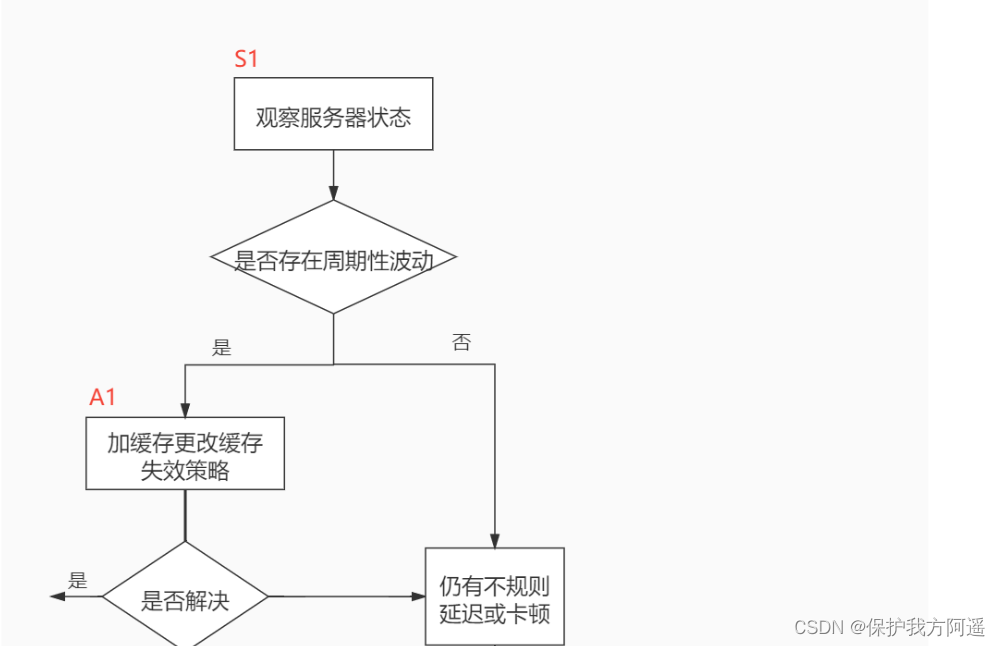
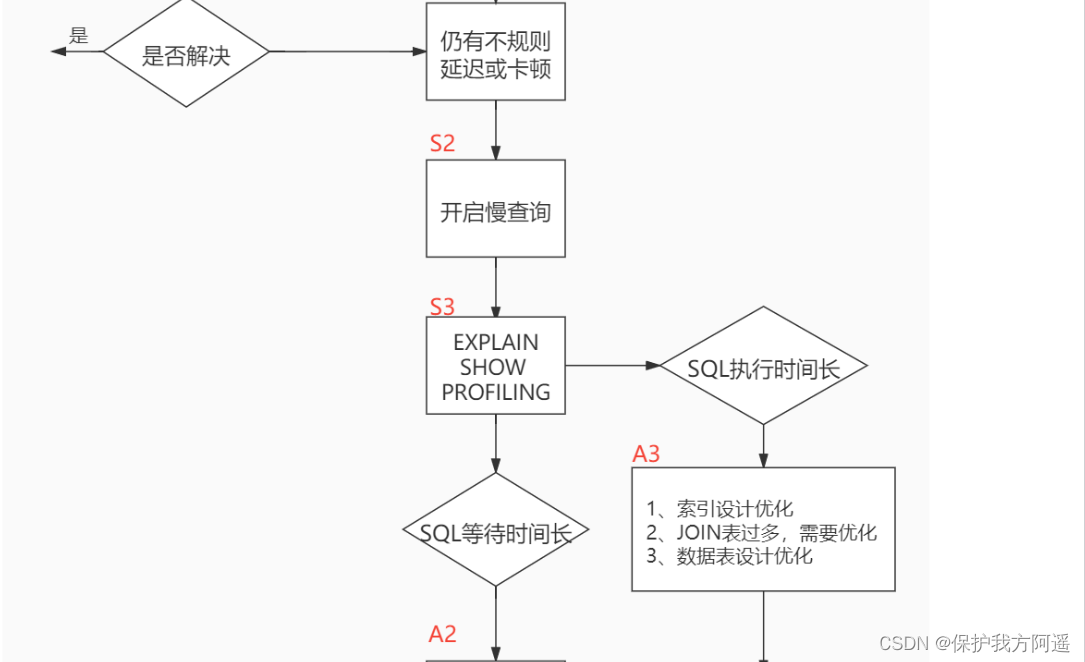
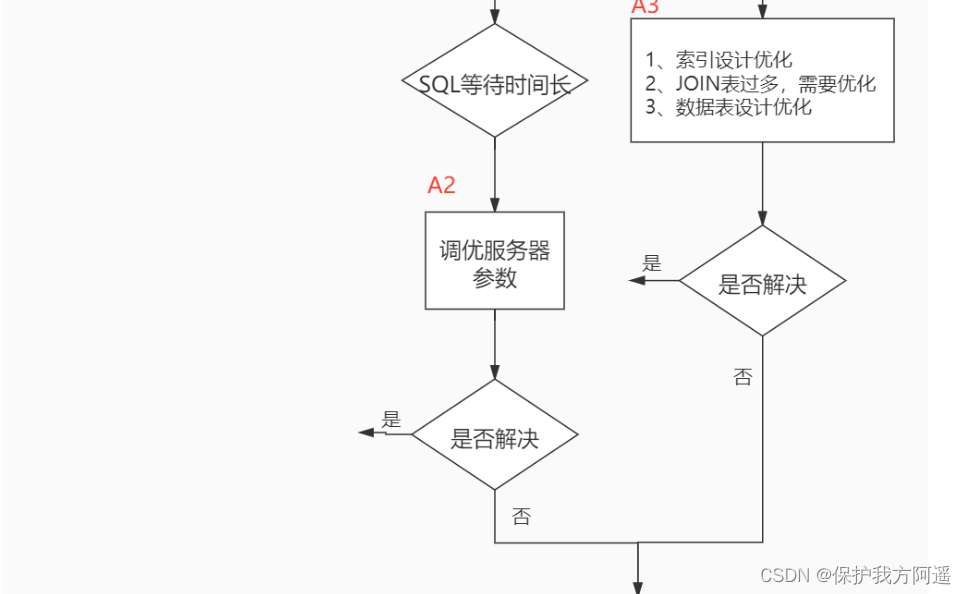

Summary :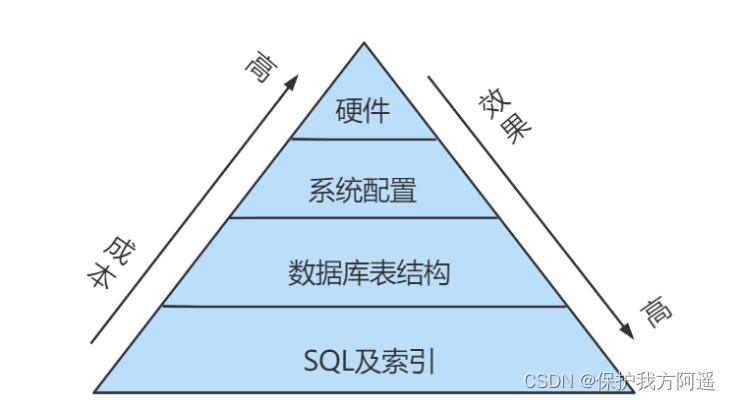
Two . View system performance parameters
stay MySQL in , have access to SHOW STATUS Statement query some MySQL Database server's performance parameter 、 Frequency of execution .
SHOW STATUS The sentence syntax is as follows :
SHOW [GLOBAL|SESSION] STATUS LIKE ' Parameters ';
Some common performance parameters are as follows :
• Connections: Connect MySQL The number of servers .
• Uptime:MySQL The online time of the server .
• Slow_queries: The number of slow queries .
• Innodb_rows_read:Select The number of rows returned by the query .
• Innodb_rows_inserted: perform INSERT The number of rows inserted by the operation .
• Innodb_rows_updated: perform UPDATE Number of rows updated by operation .
• Innodb_rows_deleted: perform DELETE The number of rows deleted by the operation .
• Com_select: Number of query operations .
• Com_insert: The number of insert operations . For batch inserted INSERT operation , Only add up once .
• Com_update: The number of update operations .
• Com_delete: The number of delete operations .
3、 ... and . Statistics SQL The cost of searching :last_query_cost
Still used student_info Table as an example :
If we want to inquire id=900001 The record of , Then look at the query cost , We can search directly on the cluster index :
SELECT student_id, class_id, NAME, create_time FROM student_info
WHERE id = 900001;

Then look at the cost of the query optimizer , In fact, we only need to retrieve one page :
SHOW STATUS LIKE 'last_query_cost';

If we want to inquire id stay 900001 To 9000100 Student records between ?
SELECT student_id, class_id, NAME, create_time FROM student_info
WHERE id BETWEEN 900001 AND 900100;
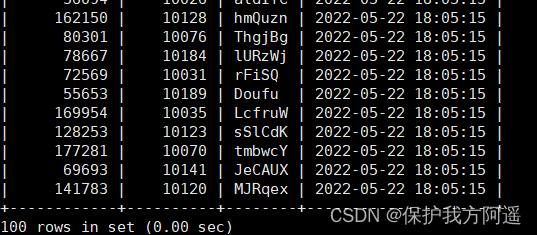
Then look at the cost of the query optimizer , At this time, we probably need to 20 A page query .
The number of pages you can see is just 20 times , However, the efficiency of query has not changed significantly , Actually these two SQL The query time is basically the same , It is because the sequential reading method is adopted to load the page into the buffer pool at one time , And then look it up . Although the number of pages (last_query_cost) A lot more , But through the mechanism of buffer pool , and Not adding much query time .
Use scenarios : It is very useful for comparing costs , Especially when we have several query methods to choose from .
Four . Location execution is slow SQL: Slow query log
4.1. Enable the slow query log parameter
4.1.1. Turn on slow_query_log
set global slow_query_log='ON';
Check whether the slow query log is enabled , And the location of slow query log files :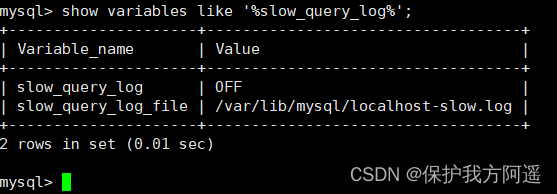
You can see that the slow query analysis has been started , At the same time, the file is saved in /var/lib/mysql/localhost-slow.log In file .
4.1.2. modify long_query_time threshold
Next, let's look at the time threshold setting of slow query , Use the following command :
show variables like '%long_query_time%';

Here, if we want to shorten the time , For example, set to 1 second , You can set it like this :
Tests found : Set up global The way to the current session Of long_query_time invalid . Valid for newly connected clients .
set global long_query_time = 1;
show global variables like '%long_query_time%';
set long_query_time=1;
show variables like '%long_query_time%'
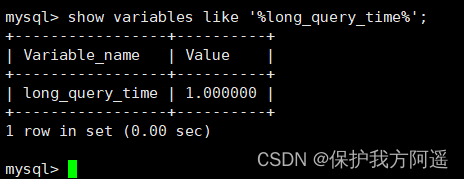
4.2. View the number of slow queries
Query how many slow query records are in the current system
SHOW GLOBAL STATUS LIKE '%Slow_queries%';
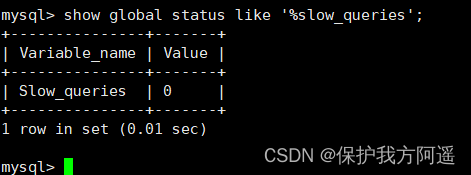
4.3. Case presentation
4.3.1. Build table
CREATE TABLE `student` (
`id` INT(11) NOT NULL AUTO_INCREMENT,
`stuno` INT NOT NULL ,
`name` VARCHAR(20) DEFAULT NULL,
`age` INT(3) DEFAULT NULL,
`classId` INT(11) DEFAULT NULL,
PRIMARY KEY (`id`)
) ENGINE=INNODB AUTO_INCREMENT=1 DEFAULT CHARSET=utf8;
4.3.2. Set parameters log_bin_trust_function_creators
Create a function , If it's wrong :
This function has none of DETERMINISTIC......
Command on : Allows you to create function settings :
set global log_bin_trust_function_creators=1; # No addition global Only the current window is valid .
4.3.3. Create a function
Randomly generate strings :
DELIMITER //
CREATE FUNCTION rand_string(n INT)
RETURNS VARCHAR(255) # This function returns a string
BEGIN
DECLARE chars_str VARCHAR(100) DEFAULT
'abcdefghijklmnopqrstuvwxyzABCDEFJHIJKLMNOPQRSTUVWXYZ';
DECLARE return_str VARCHAR(255) DEFAULT '';
DECLARE i INT DEFAULT 0;
WHILE i < n DO
SET return_str =CONCAT(return_str,SUBSTRING(chars_str,FLOOR(1+RAND()*52),1));
SET i = i + 1;
END WHILE;
RETURN return_str;
END //
DELIMITER ;
# test
SELECT rand_string(10);
Random values are generated :
DELIMITER //
CREATE FUNCTION rand_num (from_num INT ,to_num INT) RETURNS INT(11)
BEGIN
DECLARE i INT DEFAULT 0;
SET i = FLOOR(from_num +RAND()*(to_num - from_num+1)) ;
RETURN i;
END //
DELIMITER ;
# test :
SELECT rand_num(10,100);
4.3.4. Create stored procedure
DELIMITER //
CREATE PROCEDURE insert_stu1( START INT , max_num INT )
BEGIN
DECLARE i INT DEFAULT 0;
SET autocommit = 0; # Set up manual commit transactions
REPEAT # loop
SET i = i + 1; # assignment
INSERT INTO student (stuno, NAME ,age ,classId ) VALUES
((START+i),rand_string(6),rand_num(10,100),rand_num(10,1000));
UNTIL i = max_num
END REPEAT;
COMMIT; # Commit transaction
END //
DELIMITER ;
4.3.5. Calling stored procedure
# Call the function just written , 4000000 Bar record , from 100001 The start
CALL insert_stu1(100001,4000000);
4.4. Testing and analysis
4.4.1. test
SELECT * FROM student WHERE stuno = 3455655;
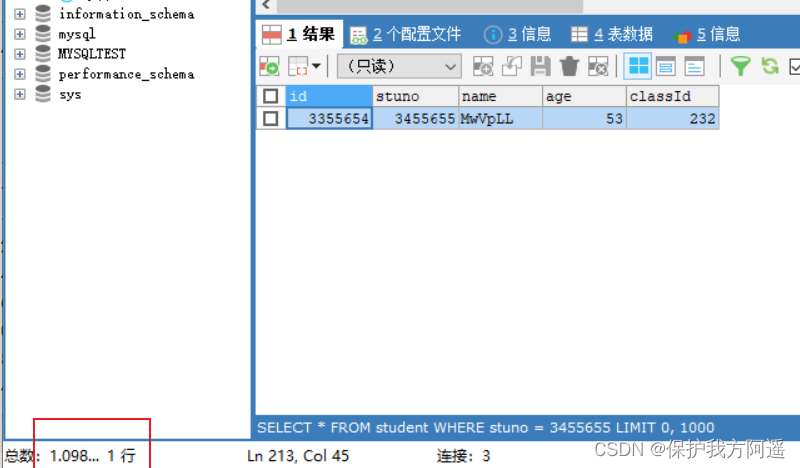
SELECT * FROM student WHERE name = 'oQmLUr';
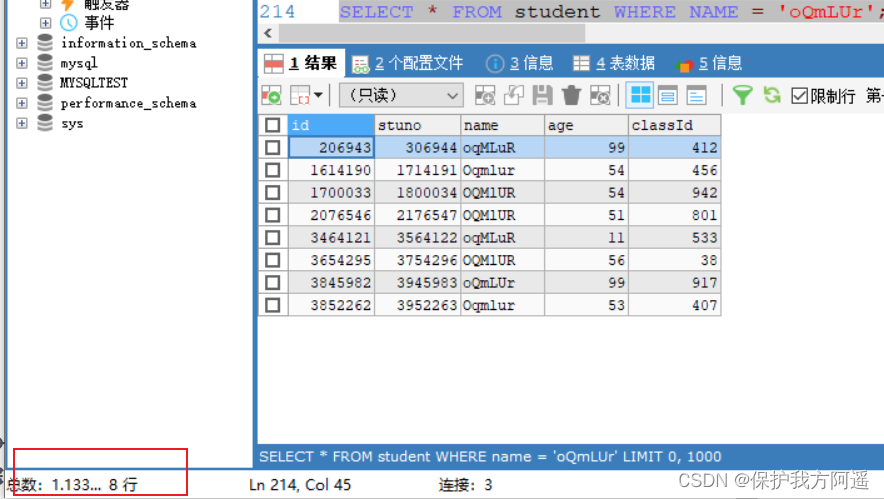
It can be seen from the results above , The inquiry student number is “3455655” The time spent on student information is 1.09 second . The student's name is “oQmLUr” The time spent on student information is 1.13 second . It has reached the order of seconds , It shows that the current query efficiency is relatively low , Now let's analyze the reasons .
4.4.2. analysis
show status like 'slow_queries';
4.5. Slow query log analysis tool :mysqldumpslow
In the production environment , If you want to analyze the log manually , lookup 、 analysis SQL, It's obviously individual work ,MySQL Provides log analysis tools mysqldumpslow .
see mysqldumpslow Help for
mysqldumpslow --help
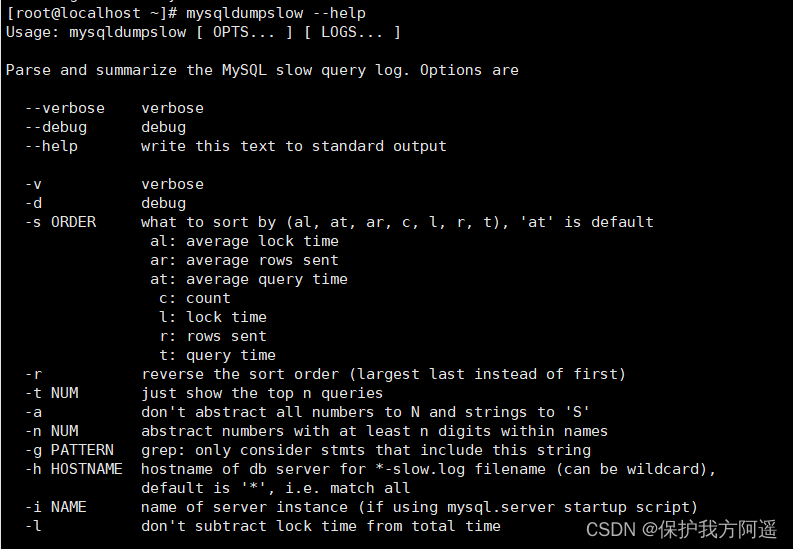 mysqldumpslow The specific parameters of the command are as follows :
mysqldumpslow The specific parameters of the command are as follows :
- -a: Do not abstract numbers into N, The string is abstracted into S
- -s: Is to show how to sort :
c: Number of visits
l: Lock time
r: Back to the record
t: Query time
al: Average lock time
ar: Average number of returned records
at: Average query time ( Default mode )
ac: Average number of queries - -t: That is, how many pieces of data are returned ;
- -g: With a regular match pattern at the back , Case insensitive ;
give an example : We want to sort by query time , Check the first five SQL sentence , Write it like this :
mysqldumpslow -s t -t 5 /var/lib/mysql/localhost-slow.log

Common references for work :
# Get the most returned recordset 10 individual SQL
mysqldumpslow -s r -t 10 /var/lib/mysql/localhost-slow.log
# The most visited 10 individual SQL
mysqldumpslow -s c -t 10 /var/lib/mysql/localhost-slow.log
# Get the top... In chronological order 10 There are left connected query statements in the bar
mysqldumpslow -s t -t 10 -g "left join" /var/lib/mysql/localhost-slow.log
# It is also recommended to use these commands in conjunction with | and more Use , Otherwise, the screen may explode
mysqldumpslow -s r -t 10 /var/lib/mysql/localhost-slow.log | more
4.6. Turn off slow query log
MySQL There are two ways for the server to stop the slow query log function :
The way 1: Permanent way
[mysqld]
slow_query_log=OFF
perhaps , hold slow_query_log Comment out one item or Delete
[mysqld]
#slow_query_log =OFF
restart MySQL service , Execute the following statement to query the slow log function .
HOW VARIABLES LIKE '%slow%'; # Query the directory where the slow query log is located
SHOW VARIABLES LIKE '%long_query_time%'; # Query timeout
The way 2: Temporary way
Use SET Statement . (1) stop it MySQL Slow query log function , Specifically SQL The statement is as follows .
SET GLOBAL slow_query_log=off
restart MySQL service , Use SHOW Statement query slow query log function information , Specifically SQL The statement is as follows
SHOW VARIABLES LIKE '%slow%';
# as well as
SHOW VARIABLES LIKE '%long_query_time%'
5、 ... and . see SQL Execution cost :SHOW PROFILE
show variables like 'profiling';
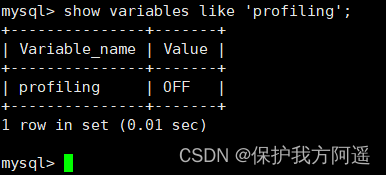 By setting profiling='ON’ To open show profile:
By setting profiling='ON’ To open show profile:
set profiling = 'ON';
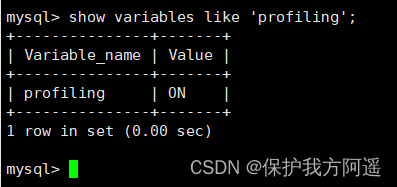
Then execute the relevant query statement . Next, let's look at the current conversation profiles, Use this command :
show profiles;

show profile cpu,block io for query 6;
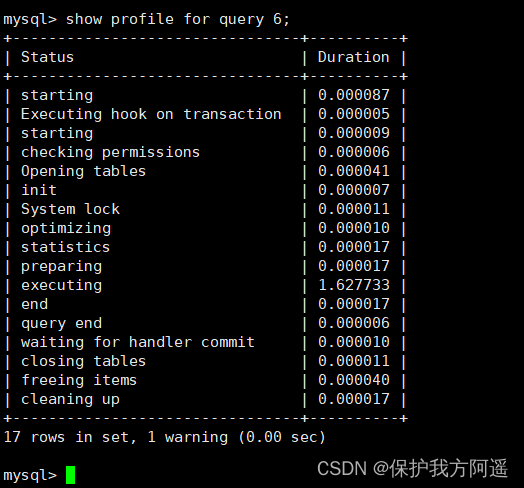 show profile Common query parameters of :
show profile Common query parameters of :
① ALL: Show all overhead information .
② BLOCK IO: Display block IO expenses .
③ CONTEXT SWITCHES: Context switching overhead .
④ CPU: Show CPU Overhead information .
⑤ IPC: Show send and receive overhead information .
⑥ MEMORY: Display memory overhead information .
⑦ PAGE FAULTS: Display page error overhead information .
⑧ SOURCE: Display and Source_function,Source_file,Source_line Related expense information . ⑨ SWAPS: Shows the number of exchanges overhead information .
6、 ... and . Analyze query statements :EXPLAIN
6.1. summary
https://dev.mysql.com/doc/refman/5.7/en/explain-output.html
https://dev.mysql.com/doc/refman/8.0/en/explain-output.html
Version :
- MySQL 5.6.3 Before, I could only EXPLAIN SELECT ;MYSQL 5.6.3 In the future EXPLAIN SELECT,UPDATE,DELETE
- stay 5.7 In previous versions , Want to show partitions Need to use explain partitions command ; Want to show pfiltered Need to use explain extended command . stay 5.7 After version , Default explain Direct display partitions and filtered Information in .
6.2. Basic grammar
EXPLAIN or DESCRIBE The syntax of the statement is as follows :
EXPLAIN SELECT select_options
perhaps
DESCRIBE SELECT select_options
If we want to see the execution plan of a query , You can add a... Before the specific query statement EXPLAIN , Just like this. :
EXPLAIN SELECT 1;
 EXPLAIN The functions of each column output by the statement are as follows :
EXPLAIN The functions of each column output by the statement are as follows :
| Name | describe |
|---|---|
| id | In a large query statement, each SELECT Each keyword corresponds to a Unique id |
| select_type | SELECT The type of query corresponding to the keyword |
| table | Table name |
| partitions | Matching partition information |
| type | Access methods for single tables |
| possible_keys | Possible indexes |
| key | Index actually used |
| key_len | The actual index length used |
| ref | When using index column equivalent queries , Information about the object matching the index column |
| rows | Estimated number of records to read |
| filtered | The percentage of records remaining after a table is filtered by search criteria |
| Extra | Some extra information |
6.3. Data preparation
6.3.1. Build table
CREATE TABLE s1 (
id INT AUTO_INCREMENT,
key1 VARCHAR(100),
key2 INT,
key3 VARCHAR(100),
key_part1 VARCHAR(100),
key_part2 VARCHAR(100),
key_part3 VARCHAR(100),
common_field VARCHAR(100),
PRIMARY KEY (id),
INDEX idx_key1 (key1),
UNIQUE INDEX idx_key2 (key2),
INDEX idx_key3 (key3),
INDEX idx_key_part(key_part1, key_part2, key_part3)
) ENGINE=INNODB CHARSET=utf8;
CREATE TABLE s2 (
id INT AUTO_INCREMENT,
key1 VARCHAR(100),
key2 INT,
key3 VARCHAR(100),
key_part1 VARCHAR(100),
key_part2 VARCHAR(100),
key_part3 VARCHAR(100),
common_field VARCHAR(100),
PRIMARY KEY (id),
INDEX idx_key1 (key1),
UNIQUE INDEX idx_key2 (key2),
INDEX idx_key3 (key3),
INDEX idx_key_part(key_part1, key_part2, key_part3)
) ENGINE=INNODB CHARSET=utf8;
6.3.2. Set parameters log_bin_trust_function_creators
Create a function , If it's wrong , You need to start the following command : Allows you to create function settings :
set global log_bin_trust_function_creators=1; # No addition global Only the current window is valid .
6.3.3. Create a function
DELIMITER //
CREATE FUNCTION rand_string1(n INT)
RETURNS VARCHAR(255) # This function returns a string
BEGIN
DECLARE chars_str VARCHAR(100) DEFAULT
'abcdefghijklmnopqrstuvwxyzABCDEFJHIJKLMNOPQRSTUVWXYZ';
DECLARE return_str VARCHAR(255) DEFAULT '';
DECLARE i INT DEFAULT 0;
WHILE i < n DO
SET return_str =CONCAT(return_str,SUBSTRING(chars_str,FLOOR(1+RAND()*52),1));
SET i = i + 1;
END WHILE;
RETURN return_str;
END //
DELIMITER ;
6.3.4. Create stored procedure
DELIMITER //
CREATE PROCEDURE insert_s1 (IN min_num INT (10),IN max_num INT (10))
BEGIN
DECLARE i INT DEFAULT 0;
SET autocommit = 0;
REPEAT
SET i = i + 1;
INSERT INTO s1 VALUES(
(min_num + i),
rand_string1(6),
(min_num + 30 * i + 5),
rand_string1(6),
rand_string1(10),
rand_string1(5),
rand_string1(10),
rand_string1(10));
UNTIL i = max_num
END REPEAT;
COMMIT;
END //
DELIMITER ;
To create s2 A stored procedure that inserts data into a table :
DELIMITER //
CREATE PROCEDURE insert_s2 (IN min_num INT (10),IN max_num INT (10))
BEGIN
DECLARE i INT DEFAULT 0;
SET autocommit = 0;
REPEAT
SET i = i + 1;
INSERT INTO s2 VALUES(
(min_num + i),
rand_string1(6),
(min_num + 30 * i + 5),
rand_string1(6),
rand_string1(10),
rand_string1(5),
rand_string1(10),
rand_string1(10));
UNTIL i = max_num
END REPEAT;
COMMIT;
END //
DELIMITER ;
6.3.5. Calling stored procedure
s1 Addition of table data : Join in 1 Ten thousand records :
CALL insert_s1(10001,10000);
s2 Addition of table data : Join in 1 Ten thousand records :
CALL insert_s2(10001,10000);
6.4. EXPLAIN Action of each column
In order to let everyone have a better experience , We adjusted EXPLAIN Order of output columns .
6.4.1. table
No matter how complex our query statement is , inside How many tables are included , In the end, each table needs to be Single table access Of , therefore MySQL Regulations EXPLAIN Each record output by the statement corresponds to the access method of a single table , Of this record table The column represents the table name of the table ( Sometimes it's not a real name , It may be abbreviated as ).
EXPLAIN SELECT id FROM s1;

6.4.2. id
The query statements we write are generally based on SELECT Keyword start , There is only one simple query statement SELECT keyword , For example, the following query statement :
SELECT * FROM s1 WHERE key1 = 'a';
There is only one in a slightly more complex join query SELECT keyword , such as :
SELECT * FROM s1 INNER JOIN s2
ON s1.key1 = s2.key1
WHERE s1.common_field = 'a';
EXPLAIN SELECT * FROM s1 WHERE key1 = 'a';

explain SELECT * FROM s1 INNER JOIN s2
ON s1.key1 = s2.key1
WHERE s1.common_field = 'a';

EXPLAIN SELECT * FROM s1 WHERE key1 IN (SELECT key1 FROM s2) OR key3 = 'a';

EXPLAIN SELECT * FROM s1 WHERE key1 IN (SELECT key2 FROM s2 WHERE common_field
= 'a');

EXPLAIN SELECT * FROM s1 UNION SELECT * FROM s2;

EXPLAIN SELECT * FROM s1 UNION ALL SELECT * FROM s2;
 Summary :
Summary :
- id If the same , It can be thought of as a group , From top to bottom .
- In all groups ,id The bigger the value is. , The higher the priority , Execute first .
- concerns :id Number, each number , Represents an independent query , One sql The fewer query times, the better .
6.4.3. select_type
| name | describe |
|---|---|
| SIMPLE | Simple SELECT (not using UNION or subqueries) |
| PRIMARY | Outermost SELECT |
| UNION | Second or later SELECT statement in a UNION |
| UNION RESULT | Result of a UNION |
| SUBQUERY | First SELECT in subquery |
| DEPENDENT SUBQUERY | First SELECT in subquery, dependent on outer query |
| DEPENDENT UNION | Second or later SELECT statement in a UNION, dependent on outer query |
| DERIVED | Derived table |
| MATERIALIZED | Materialized subquery |
| UNCACHEABLE SUBQUERY | A subquery for which the result cannot be cached and must be re-evaluated for each row of the outer query |
| UNCACHEABLE UNION | The second or later select in a UNION that belongs to an uncacheable subquery(see UNCACHEABLE SUBQUERY) |
The specific analysis is as follows :
EXPLAIN SELECT * FROM s1;

Of course , Join query is also SIMPLE type , such as :
EXPLAIN SELECT * FROM s1 INNER JOIN s2;

EXPLAIN SELECT * FROM s1 UNION SELECT * FROM s2;

EXPLAIN SELECT * FROM s1 WHERE key1 IN (SELECT key1 FROM s2) OR key3 = 'a';

EXPLAIN SELECT * FROM s1 WHERE key1 IN (SELECT key1 FROM s2 WHERE s1.key2 =s2.key2) OR key3 = 'a';

EXPLAIN SELECT * FROM s1 WHERE key1 IN (SELECT key1 FROM s2 WHERE key1 =
'a' UNION SELECT key1 FROM s1 WHERE key1 = 'b');

EXPLAIN SELECT * FROM (SELECT key1, count(*) as c FROM s1 GROUP BY key1) AS
derived_s1 where c > 1;

EXPLAIN SELECT * FROM s1 WHERE key1 IN (SELECT key1 FROM s2);

6.4.4. partitions
Create a partition table :
-- Create a partition table ,
-- according to id Partition ,id<100 p0 Partition , other p1 Partition
CREATE TABLE user_partitions (id INT auto_increment,
NAME VARCHAR(12),PRIMARY KEY(id))
PARTITION BY RANGE(id)(
PARTITION p0 VALUES less than(100),
PARTITION p1 VALUES less than MAXVALUE
);
DESC SELECT * FROM user_partitions WHERE id>200;

6.4.5. type
The complete access method is as follows : system , const , eq_ref , ref , fulltext , ref_or_null ,index_merge , unique_subquery , index_subquery , range , index , ALL .
- system
CREATE TABLE t(i int) Engine=MyISAM;
INSERT INTO t VALUES(1);
EXPLAIN SELECT * FROM t;

- const
EXPLAIN SELECT * FROM s1 WHERE id = 10005;

- eq_ref
EXPLAIN SELECT * FROM s1 INNER JOIN s2 ON s1.id = s2.id;
 As can be seen from the results of the implementation plan ,MySQL Intend to s2 As a driving table ,s1 As a driven table , Focus on s1 Your access method is eq_ref , Indicates that you are visiting s1 When you watch, you can Through the equivalence matching of the primary key To visit .
As can be seen from the results of the implementation plan ,MySQL Intend to s2 As a driving table ,s1 As a driven table , Focus on s1 Your access method is eq_ref , Indicates that you are visiting s1 When you watch, you can Through the equivalence matching of the primary key To visit .
- ref
EXPLAIN SELECT * FROM s1 WHERE key1 = 'a';

- fulltext
Full-text index - ref_or_null
EXPLAIN SELECT * FROM s1 WHERE key1 = 'a' OR key1 IS NULL;

- index_merge
EXPLAIN SELECT * FROM s1 WHERE key1 = 'a' OR key3 = 'a';
 From the implementation of the plan type Is the value of the column index_merge We can see that ,MySQL I plan to use index merging to execute
From the implementation of the plan type Is the value of the column index_merge We can see that ,MySQL I plan to use index merging to execute
Yes s1 Table in the query .
- unique_subquery
EXPLAIN SELECT * FROM s1 WHERE key2 IN (SELECT id FROM s2 where s1.key1 =
s2.key1) OR key3 = 'a';

- index_subquery
EXPLAIN SELECT * FROM s1 WHERE common_field IN (SELECT key3 FROM s2 where
s1.key1 = s2.key1) OR key3 = 'a';

- range
EXPLAIN SELECT * FROM s1 WHERE key1 IN ('a', 'b', 'c');

- index
EXPLAIN SELECT key_part2 FROM s1 WHERE key_part3 = 'a';

- ALL
EXPLAIN SELECT * FROM s1;

The result value from the best to the worst is : system > const > eq_ref > ref > fulltext > ref_or_null > index_merge >
unique_subquery > index_subquery > range > index > ALL Some of the more important ones are extracted ( See blue in the picture above ).SQL Objectives of performance optimization : At the very least range Level , The requirement is ref Level , It is best to consts Level .( Alibaba development manual requirements )
6.4.6. possible_keys and key

6.4.7. key_len
EXPLAIN SELECT * FROM s1 WHERE id = 10005;

EXPLAIN SELECT * FROM s1 WHERE key2 = 10126;

EXPLAIN SELECT * FROM s1 WHERE key1 = 'a';

EXPLAIN SELECT * FROM s1 WHERE key_part1 = 'a' AND key_part2 = 'b';

key_len The length formula of :
varchar(10) Variable length field and allow NULL = 10 * ( character set:utf8=3,gbk=2,latin1=1)+1(NULL)+2( Variable length field )
varchar(10) Variable length field and not allowed NULL = 10 * ( character set:utf8=3,gbk=2,latin1=1)+2( Variable length field )
char(10) Fixed field and allow NULL = 10 * ( character set:utf8=3,gbk=2,latin1=1)+1(NULL)
char(10) Fixed field and not allowed NULL = 10 * ( character set:utf8=3,gbk=2,latin1=1)
6.4.8. ref
EXPLAIN SELECT * FROM s1 WHERE key1 = 'a';

EXPLAIN SELECT * FROM s1 INNER JOIN s2 ON s1.id = s2.id;

EXPLAIN SELECT * FROM s1 INNER JOIN s2 ON s2.key1 = UPPER(s1.key1);

6.4.9. rows
EXPLAIN SELECT * FROM s1 WHERE key1 > 'z';

6.4.10. filtered
EXPLAIN SELECT * FROM s1 WHERE key1 > 'z' AND common_field = 'a';

6.4.5. Summary
- EXPLAIN Don't think about all kinds of Cache.
- EXPLAIN Can't show MySQL Optimizations done when executing queries .
- EXPLAIN I won't tell you about triggers 、 The impact of stored procedure information or user-defined functions on queries .
- Some of the statistics are estimated , Not exactly .
7、 ... and . EXPLAIN Further use of
7.1. EXPLAIN Four output formats
EXPLAIN You can output four formats : Traditional format , JSON Format , TREE Format as well as Visual output . Users can choose their own format according to their needs .
7.2. Traditional format
The traditional format is simple and clear , The output is a tabular form , Outline query plan .
EXPLAIN SELECT s1.key1, s2.key1 FROM s1 LEFT JOIN s2 ON s1.key1 = s2.key1 WHERE
s2.common_field IS NOT NULL;

7.3. JSON Format
JSON Format : stay EXPLAIN Add... Between the word and the real query statement FORMAT=JSON .
EXPLAIN FORMAT=JSON SELECT ....
We use # The form followed by notes explains EXPLAIN FORMAT=JSON The output of the statement , But you may have questions “cost_info” The cost inside looks strange , How are they calculated ? First look at s1 Tabular “cost_info” Ministry
branch :
"cost_info": {
"read_cost": "1840.84",
"eval_cost": "193.76",
"prefix_cost": "2034.60",
"data_read_per_join": "1M"
}
read_cost It's made up of the two parts below :
- IO cost
- testing rows × (1 - filter) Bar record CPU cost
Tips: : rows and filter All of them are the output columns of our previous introduction to the implementation plan , stay JSON Format of the implementation plan ,rows
amount to rows_examined_per_scan,filtered The name does not change .
- eval_cost This is how it is calculated :
testing rows × filter Cost of records . - prefix_cost It's a separate query s1 Cost of tables , That is to say :read_cost + eval_cost
- data_read_per_join Represents the amount of data to be read in this query .
about s2 Tabular “cost_info” Part of it is like this :
"cost_info": {
"read_cost": "968.80",
"eval_cost": "193.76",
"prefix_cost": "3197.16",
"data_read_per_join": "1M"
}
because s2 A table is a driven table , So it can be read many times , there read_cost and eval_cost It's a visit many times s2 The cumulative value at the end of the table , We are mainly concerned about the prefix_cost The value of represents the estimated cost of the entire join query , It's a single query s1 Tables and multiple queries s2 The sum of the cost after the table , That is to say :
968.80 + 193.76 + 2034.60 = 3197.16
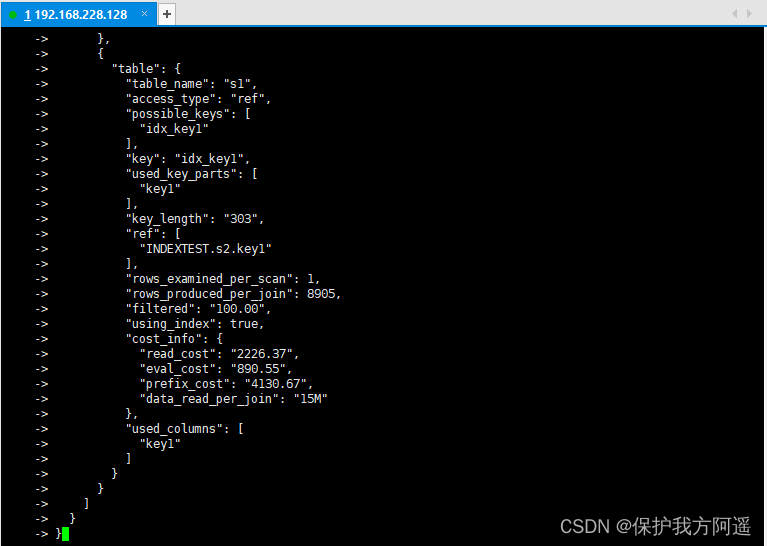
7.4. TREE Format
TREE The format is 8.0.16 New format introduced after version , Mainly based on the query The relationship between the parts and Execution sequence of each part To describe how to query .
EXPLAIN FORMAT=tree SELECT * FROM s1 INNER JOIN s2 ON s1.key1 = s2.key2 WHERE
s1.common_field = 'a'\G

7.5. Visual output
Visual output , Can pass MySQL Workbench Visual view MySQL Implementation plan of . By clicking on Workbench Magnifying glass icon , You can generate a visual query plan .
EXPLAIN SELECT s1.key1, s2.key1 FROM s1 LEFT JOIN s2 ON s1.key1 = s2.key1 WHERE
s2.common_field IS NOT NULL;
SHOW WARNINGS\G;
*************************** 1. row ***************************
Level: Note
Code: 1003
Message: /* select#1 */ select `atguigu`.`s1`.`key1` AS `key1`,`atguigu`.`s2`.`key1`
AS `key1` from `atguigu`.`s1` join `atguigu`.`s2` where ((`atguigu`.`s1`.`key1` =
`atguigu`.`s2`.`key1`) and (`atguigu`.`s2`.`common_field` is not null))
1 row in set (0.00 sec)
8、 ... and . Analyze optimizer execution plan :trace
SET optimizer_trace="enabled=on",end_markers_in_json=on;
set optimizer_trace_max_mem_size=1000000;
After opening , The following statements can be analyzed :
- SELECT
- INSERT
- REPLACE
- UPDATE
- DELETE
- EXPLAIN
- SET
- DECLARE
- CASE
- IF
- RETURN
- CALL
test : The implementation is as follows SQL sentence
select * from student where id < 10;
Last , Inquire about information_schema.optimizer_trace We can know MySQL How to execute SQL Of :
select * from information_schema.optimizer_trace\G
*************************** 1. row ***************************
// The first 1 part : Query statement
QUERY: select * from student where id < 10
// The first 2 part :QUERY The tracking information of the statement corresponding to the field
TRACE: {
"steps": [
{
"join_preparation": { // Preparatory work
"select#": 1,
"steps": [
{
"expanded_query": "/* select#1 */ select `student`.`id` AS `id`,`student`.`student_no` AS `student_no`,`student`.`student_name` AS `student_name` from `student` where (`student`.`id` < 10)"
}
] /* steps */
} /* join_preparation */
},
{
"join_optimization": {// To optimize
"select#": 1,
"steps": [
{
"condition_processing": { // Conditional processing
"condition": "WHERE",
"original_condition": "(`student`.`id` < 10)",
"steps": [
{
"transformation": "equality_propagation",
"resulting_condition": "(`student`.`id` < 10)"
},
{
"transformation": "constant_propagation",
"resulting_condition": "(`student`.`id` < 10)"
},
{
"transformation": "trivial_condition_removal",
"resulting_condition": "(`student`.`id` < 10)"
}
] /* steps */
} /* condition_processing */
},
{
"substitute_generated_columns": { // Replace the generated column
} /* substitute_generated_columns */
},
{
"table_dependencies": [ // Table dependencies
{
"table": "`student`",
"row_may_be_null": false,
"map_bit": 0,
"depends_on_map_bits": [
] /* depends_on_map_bits */
}
] /* table_dependencies */
},
{
"ref_optimizer_key_uses": [ // Use the key
] /* ref_optimizer_key_uses */
},
{
"rows_estimation": [ // Line judgment
{
"table": "`student`",
"range_analysis": {
"table_scan": {
"rows": 1,
"cost": 3.2
} /* table_scan */, // Scan table
"potential_range_indexes": [ // Potential range index
{
"index": "PRIMARY",
"usable": true,
"key_parts": [
"id"
] /* key_parts */
}
] /* potential_range_indexes */,
"setup_range_conditions": [ // Set range conditions
] /* setup_range_conditions */,
"group_index_range": {
"chosen": false,
"cause": "not_group_by_or_distinct"
} /* group_index_range */,
"skip_scan_range": {
"potential_skip_scan_indexes": [
{
"index": "PRIMARY",
"usable": false,
"cause": "query_references_nonkey_column"
}
] /* potential_skip_scan_indexes */
} /* skip_scan_range */,
"analyzing_range_alternatives": { // Analysis range options
"range_scan_alternatives": [
{
"index": "PRIMARY",
"ranges": [
"id < 10"
] /* ranges */,
"index_dives_for_eq_ranges": true,
"rowid_ordered": true,
"using_mrr": false,
"index_only": false,
"rows": 1,
"cost": 1.11,
"chosen": true
}
] /* range_scan_alternatives */,
"analyzing_roworder_intersect": {
"usable": false,
"cause": "too_few_roworder_scans"
} /* analyzing_roworder_intersect */
} /* analyzing_range_alternatives */,
"chosen_range_access_summary": { // Select the scope to access the summary
"range_access_plan": {
"type": "range_scan",
"index": "PRIMARY",
"rows": 1,
"ranges": [
"id < 10"
] /* ranges */
} /* range_access_plan */,
"rows_for_plan": 1,
"cost_for_plan": 1.11,
"chosen": true
} /* chosen_range_access_summary */
} /* range_analysis */
}
] /* rows_estimation */
},
{
"considered_execution_plans": [ // Consider implementation plan
{
"plan_prefix": [
] /* plan_prefix */,
"table": "`student`",
"best_access_path": { // Best access path
"considered_access_paths": [
{
"rows_to_scan": 1,
"access_type": "range",
"range_details": {
"used_index": "PRIMARY"
} /* range_details */,
"resulting_rows": 1,
"cost": 1.21,
"chosen": true
}
] /* considered_access_paths */
} /* best_access_path */,
"condition_filtering_pct": 100, // Row filter percentage
"rows_for_plan": 1,
"cost_for_plan": 1.21,
"chosen": true
}
] /* considered_execution_plans */
},
{
"attaching_conditions_to_tables": { // Attach the condition to the table
"original_condition": "(`student`.`id` < 10)",
"attached_conditions_computation": [
] /* attached_conditions_computation */,
"attached_conditions_summary": [ // Summary of additional conditions
{
"table": "`student`",
"attached": "(`student`.`id` < 10)"
}
] /* attached_conditions_summary */
} /* attaching_conditions_to_tables */
},
{
"finalizing_table_conditions": [
{
"table": "`student`",
"original_table_condition": "(`student`.`id` < 10)",
"final_table_condition ": "(`student`.`id` < 10)"
}
] /* finalizing_table_conditions */
},
{
"refine_plan": [ // Streamline plans
{
"table": "`student`"
}
] /* refine_plan */
}
] /* steps */
} /* join_optimization */
},
{
"join_execution": { // perform
"select#": 1,
"steps": [
] /* steps */
} /* join_execution */
}
] /* steps */
}
// The first 3 part : When the tracking information is too long , The number of bytes of truncated trace information .
MISSING_BYTES_BEYOND_MAX_MEM_SIZE: 0 // Missing bytes exceeding maximum capacity
// The first 4 part : Whether the user executing the trace statement has permission to view the object . When you don't have permission , The column information is 1 And TRACE Field is empty , Generally in
Call with SQL SECURITY DEFINER In the case of stored procedures , This problem will arise .
INSUFFICIENT_PRIVILEGES: 0 // Missing permissions
1 row in set (0.00 sec)
mysql>
Nine . MySQL Monitor analysis view -sys schema
9.1. Sys schema View summary
- Host related : With host_summary start , It mainly summarizes IO Delayed information .
- Innodb relevant : With innodb start , Sum up innodb buffer Information and transaction waiting innodb Lock information .
- I/o relevant : With io start , Summed up waiting I/O、I/O Usage .
- Memory usage : With memory start , From host 、 Threads 、 Show the memory usage from the perspective of events .
- Connection and session information :processlist and session Related view , Summarize the conversation information .
- Table related : With schema_table The first view , Shows the statistics of the table .
- Index information : The usage of the index is counted , Including redundant indexes and unused indexes .
- Statement related : With statement start , Includes performing a full table scan 、 Use a temporary watch 、 Statement information such as sorting .
- User correlation : With user The first view , Statistics of the files used by users I/O、 Execute statement Statistics .
- Wait for information about the incident : With wait start , Show the delay of waiting Events .
9.2. Sys schema View summary
9.2.1. The index case
#1. Query redundant index
select * from sys.schema_redundant_indexes;
#2. Query unused indexes
select * from sys.schema_unused_indexes;
#3. Query index usage
select index_name,rows_selected,rows_inserted,rows_updated,rows_deleted
from sys.schema_index_statistics where table_schema='dbname' ;
9.2.2. Table related
# 1. The number of visits to the query table
select table_schema,table_name,sum(io_read_requests+io_write_requests) as io from
sys.schema_table_statistics group by table_schema,table_name order by io desc;
# 2. Query occupancy bufferpool More tables
select object_schema,object_name,allocated,data
from sys.innodb_buffer_stats_by_table order by allocated limit 10;
# 3. Check the full table scanning of the table
select * from sys.statements_with_full_table_scans where db='dbname';
9.2.3. Statement related
#1. monitor SQL Frequency of execution
select db,exec_count,query from sys.statement_analysis
order by exec_count desc;
#2. The monitoring uses sorted SQL
select db,exec_count,first_seen,last_seen,query
from sys.statements_with_sorting limit 1;
#3. Monitor the use of temporary tables or disk temporary tables SQL
select db,exec_count,tmp_tables,tmp_disk_tables,query
from sys.statement_analysis where tmp_tables>0 or tmp_disk_tables >0
order by (tmp_tables+tmp_disk_tables) desc;
9.2.4. IO relevant
#1. View consumed disks IO The file of
select file,avg_read,avg_write,avg_read+avg_write as avg_io
from sys.io_global_by_file_by_bytes order by avg_read limit 10;
9.2.5. Innodb relevant
#1. Row lock blocking
select * from sys.innodb_lock_waits;
边栏推荐
- MySQL33-多版本并发控制
- MySQL实战优化高手04 借着更新语句在InnoDB存储引擎中的执行流程,聊聊binlog是什么?
- 用于实时端到端文本识别的自适应Bezier曲线网络
- 基于Pytorch的LSTM实战160万条评论情感分类
- Southwest University: Hu hang - Analysis on learning behavior and learning effect
- Use xtrabackup for MySQL database physical backup
- Super detailed steps to implement Wechat public number H5 Message push
- Mysql32 lock
- Unicode decodeerror: 'UTF-8' codec can't decode byte 0xd0 in position 0 successfully resolved
- MySQL25-索引的创建与设计原则
猜你喜欢
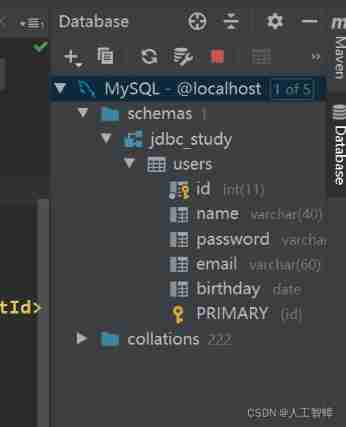
Record the first JDBC

Mysql27 index optimization and query optimization
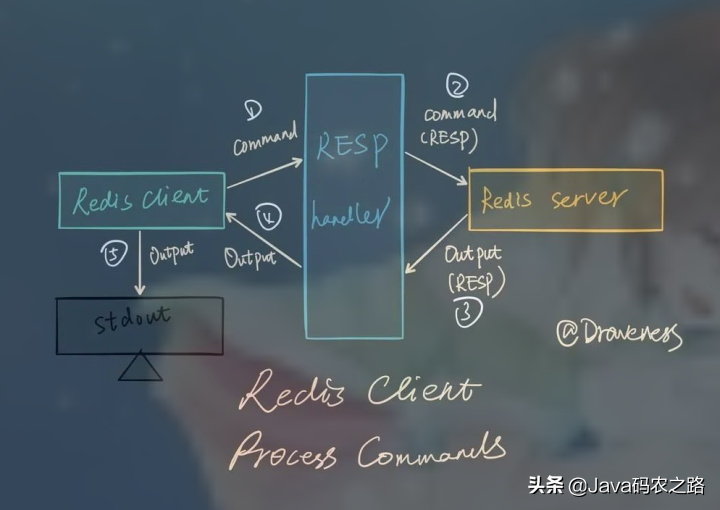
Redis集群方案应该怎么做?都有哪些方案?
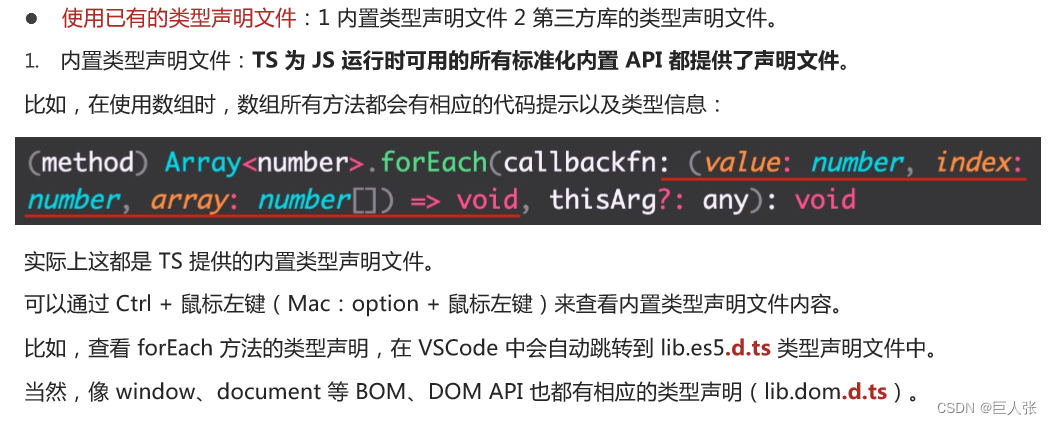
Typescript入门教程(B站黑马程序员)

Use JUnit unit test & transaction usage

Super detailed steps for pushing wechat official account H5 messages
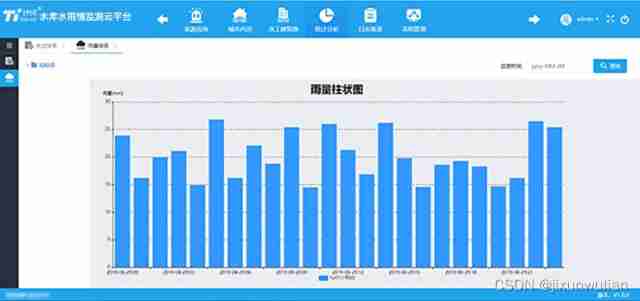
Water and rain condition monitoring reservoir water and rain condition online monitoring
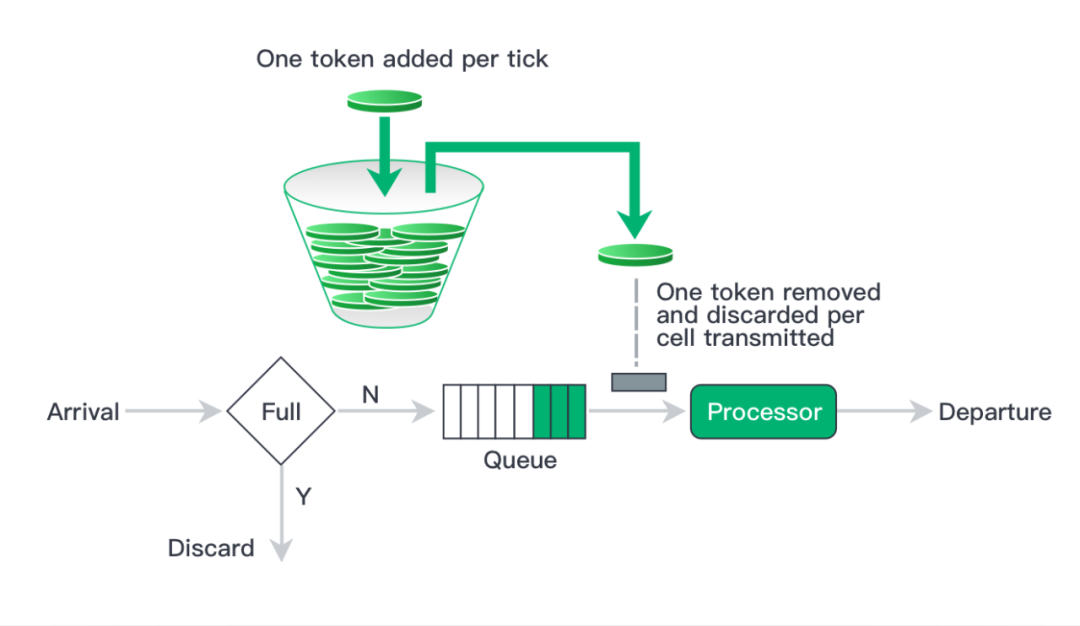
In fact, the implementation of current limiting is not complicated

Use xtrabackup for MySQL database physical backup
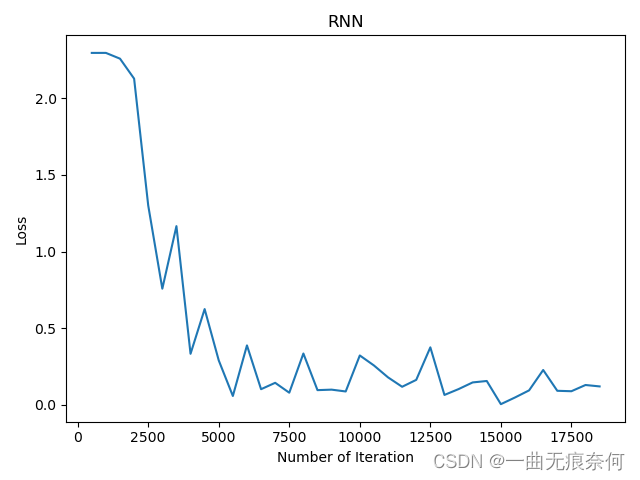
PyTorch RNN 实战案例_MNIST手写字体识别
随机推荐
Time in TCP state_ The role of wait?
CDC: the outbreak of Listeria monocytogenes in the United States is related to ice cream products
Time complexity (see which sentence is executed the most times)
MySQL combat optimization expert 02 in order to execute SQL statements, do you know what kind of architectural design MySQL uses?
MySQL实战优化高手09 生产经验:如何为生产环境中的数据库部署监控系统?
Windchill配置远程Oracle数据库连接
MySQL combat optimization expert 04 uses the execution process of update statements in the InnoDB storage engine to talk about what binlog is?
MySQL实战优化高手05 生产经验:真实生产环境下的数据库机器配置如何规划?
MySQL real battle optimization expert 08 production experience: how to observe the machine performance 360 degrees without dead angle in the process of database pressure test?
Technology | diverse substrate formats
Const decorated member function problem
颜值爆表,推荐两款JSON可视化工具,配合Swagger使用真香
14 医疗挂号系统_【阿里云OSS、用户认证与就诊人】
MySQL combat optimization expert 07 production experience: how to conduct 360 degree dead angle pressure test on the database in the production environment?
Emotional classification of 1.6 million comments on LSTM based on pytoch
pytorch的Dataset的使用
PyTorch RNN 实战案例_MNIST手写字体识别
text 文本数据增强方法 data argumentation
The appearance is popular. Two JSON visualization tools are recommended for use with swagger. It's really fragrant
If someone asks you about the consistency of database cache, send this article directly to him